As an aspiring founder of a funding platform, looking at the examples of crowdfunding websites, you may face a complex decision-making process.
Not only do they come in a variety of layouts, colors, and styles. There are also challenges in selecting the right platform, securing the payments, and ensuring a user-friendly experience for project creators and backers.
Luckily, Fireart can help you navigate the unique challenges of crowdfunding website design.
But before we get to the details and web development trends, let’s start by exploring a few examples of well-known crowdfunding sites to understand what sets them apart.
13 best examples of crowdfunding websites
When considering launching a crowdfunding campaign, understanding how to design a crowdfunding site is crucial.
These platforms offer various features and pricing models and cater to different projects. Trying to create a fascinating user experience for the website visitors, they may leverage:
- Friendly website design
- Responsive templates
- A specific website target
- Captivating imagery
- Well-written copy
- Detailed case studies
- A user-friendly content material management system (CMS)
- Quick hosting
- Engaging blog content
Let’s look at the 12 best examples of crowdfunding websites to understand what makes them exceptional.
-
patreon.com
 Website: patreon.com
Website: patreon.comPatreon is a prominent crowdfunding platform designed to support artists and content producers. It stands as a supportive ecosystem where creators can nurture their creative talents and build meaningful connections with their fans while earning a sustainable income.
Features:
- Various membership tiers, each with different benefits and exclusive content.
- Accommodation for various content across a range of genres.
- Tools for creators to engage with patrons through posts and live streams.
Pros:
- Sustainable income stream for the creators
- Fan engagement, a sense of community, and support for the fans
- Creative freedom for creators to pursue their artistic vision
Cons:
- Fees on the income received by creators can affect the overall revenue.
- It can be challenging to retain patrons over extended periods.
-
kickstarter.com
 Website: kickstarter.com
Website: kickstarter.comKickstarter is a renowned platform for creative projects, including art, technology, and design. It’s a shop window for innovative ideas and products.
Features :
- Focus on creative projects that attract artists, designers, and tech innovators.
- The all-or-nothing funding model instills a sense of commitment in backers.
- Creates a vibrant and supportive community for creative projects.
Pros:
- High visibility and a strong reputation attract a broad audience.
- Focus on creative projects carves out a unique niche in the crowdfunding space.
Cons:
- The competitive environment makes it challenging for new projects to stand out.
-
indiegogo.com
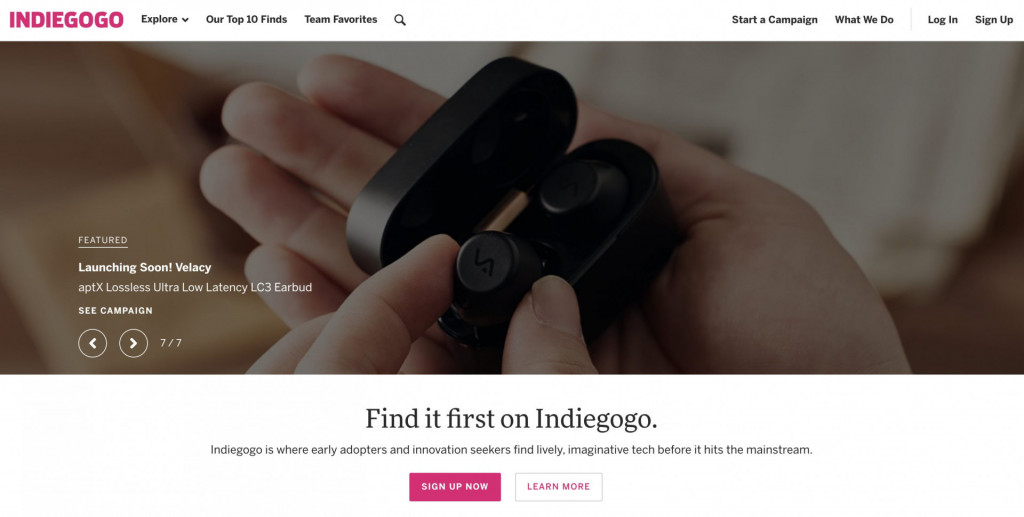
Website: indiegogo.com
Indiegogo is a popular crowdfunding platform accommodating various project types, from tech gadgets to charitable causes. Their crowdfunding website design is clear, memorable, and optimized for efficiency.
Features:
- Offers flexible funding options to attract a broader range of project creators.
- Targets global reach to appeal to a diverse array of projects and backers.
- Provides a transparent fee structure for trust-building.
Pros:
- Attracts a broad spectrum of projects, making it suitable for various creative and tech innovations.
- Targeting a global user base enhances the platform’s appeal.
Cons:
Platform fees can be relatively high, affecting the profitability.
-
startengine.com

Website: startengine.com
StartEngine is an equity crowdfunding platform ideal for startups offering equity to investors.
Features:
- Specializes in equity-based crowdfunding for startups.
- Offers detailed financial reporting tools.
- Emphasizes regulatory compliance.
Pros:
- Attracts potential investors interested in equity investments.
- Focused on regulatory compliance.
Cons:
- Managing complex legal requirements may be challenging.
-
seedrs.com
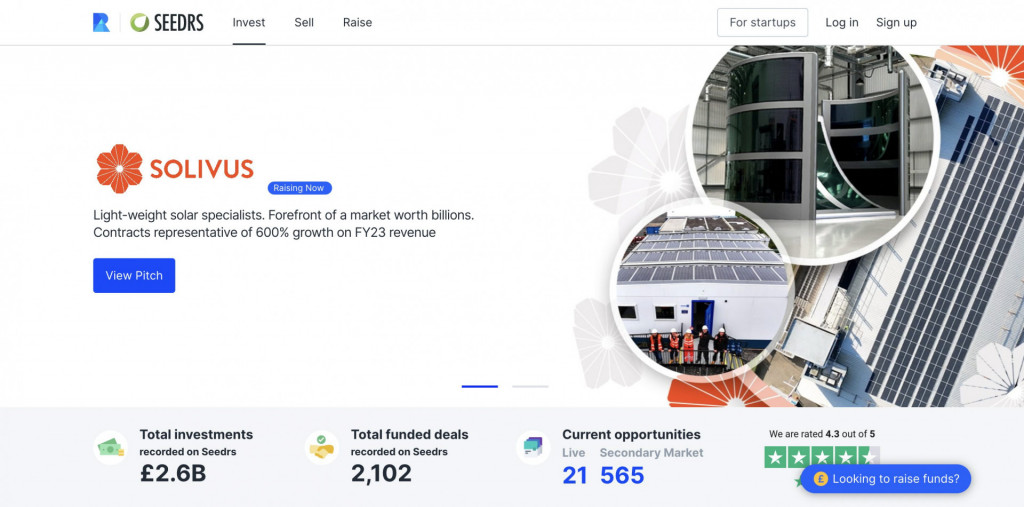
Website: seedrs.com
Among other examples of crowdfunding websites, Seedrs stands out as a renowned equity crowdfunding platform primarily focused on startups and early-stage business endeavors. It’s design is more about funding and less about the “crowd”.
Features:
- Specializes in equity-based crowdfunding for startups.
- Provides due diligence tools.
- Offers a secondary market for share trading.
Pros:
- Attracts startups seeking equity investments.
- Provides liquidity through a secondary market.
Cons:
The platform may be more suitable for investors rather than project creators.
-
republic.com
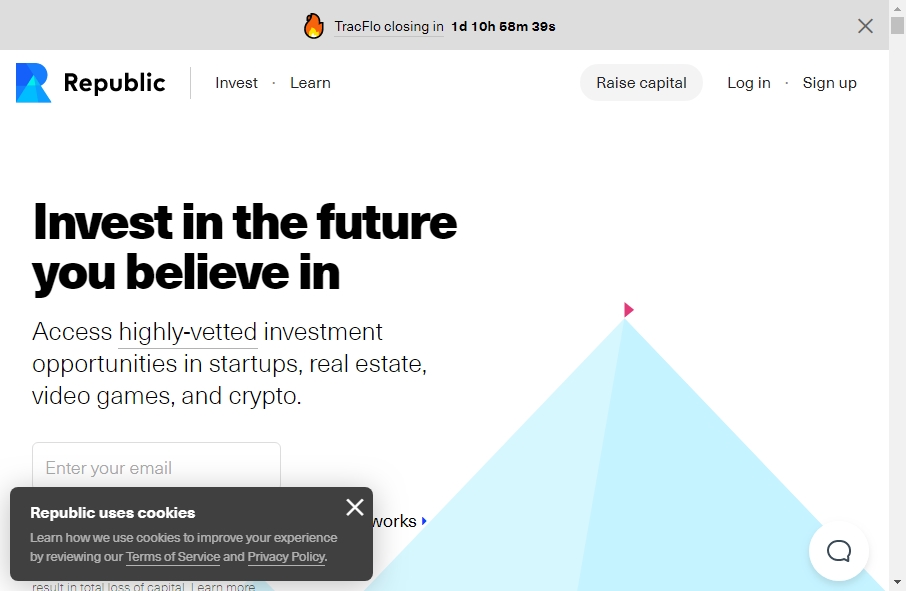
Website: republic.com
Republic.com is an equity crowdfunding platform emphasizing diversity and inclusivity in investments, suitable for startups aiming to engage a broad investor base. Crowdfunding web design here is clear and respectable, conveying the platform reliability.
Features:
- Encourages a diverse base of investors.
- Promotes community engagement.
- Emphasizes legal compliance.
Pros:
- Attracts a broad range of investors and project creators.
- Supports a solid and supportive community.
Cons:
The crowdfunding landscape may already be competitive.
-
fundable.com

Website: fundable.com
Among other sites, Fundable is tailored for early-stage businesses and startups seeking equity investments, offering comprehensive tools to help secure funding.
Features:
- Specializes in equity-based crowdfunding for early-stage businesses.
- Provides tools and resources for startups.
- Supports investor relations and transparency.
Pros:
- Attracts startups seeking equity investments.
- Facilitates networking opportunities for collaboration.
Cons:
Focused on specific business niches.
-
crowdcube.com
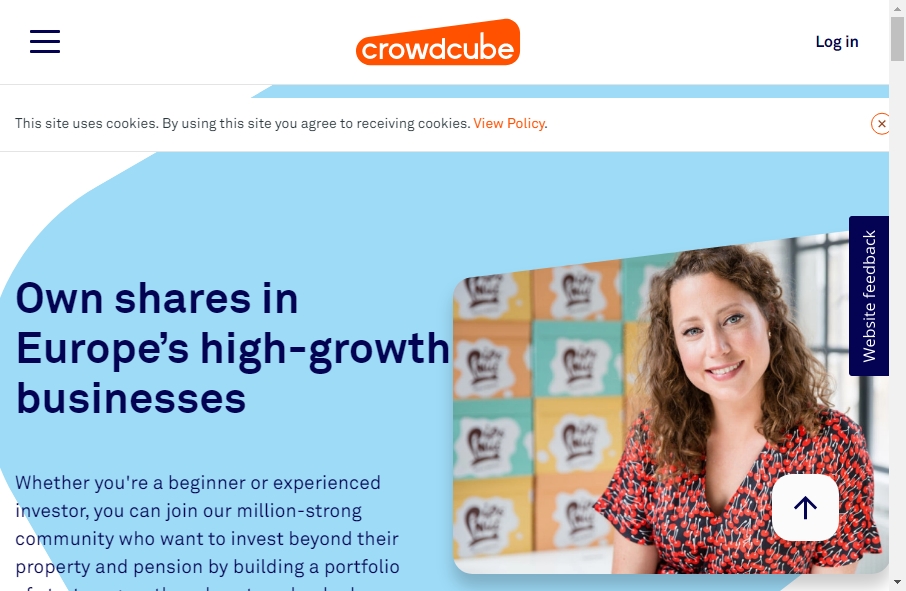
Website: crowdcube.com
Crowdcube is a top equity crowdfunding platform for UK businesses, enabling investors to buy startup shares. Their crowdfunding website design is built on on user-friendly, educative approach.
Features:
- Focuses on the UK market and attracting UK startups.
- Builds a large investor community in the UK business landscape.
- Pays attention to regulatory requirements in the UK market.
Pros:
- Attracts businesses and investors interested in UK opportunities.
- Builds a strong investor network.
Cons:
- Limited international appeal due to the UK focus.
-
crowdsupply.com

Website: crowdsupply.com
Crowd Supply stands out among other websites as it specializes in crowdfunding for open-source hardware and software projects. Their crowdfunding web design is simple and clear, focusing the readers’ attention on the projects.
Features:
- Focuses on open-source projects and hardware/software innovation.
- Attracts tech innovators and open-source enthusiasts.
- Builds a dedicated community for open-source projects.
Pros:
- A niche focus on open-source projects sets the platform apart.
- Fosters a dedicated community-enhancing project visibility.
Cons:
Limited appeal to a broader range of projects and backers.
-
experiment.com
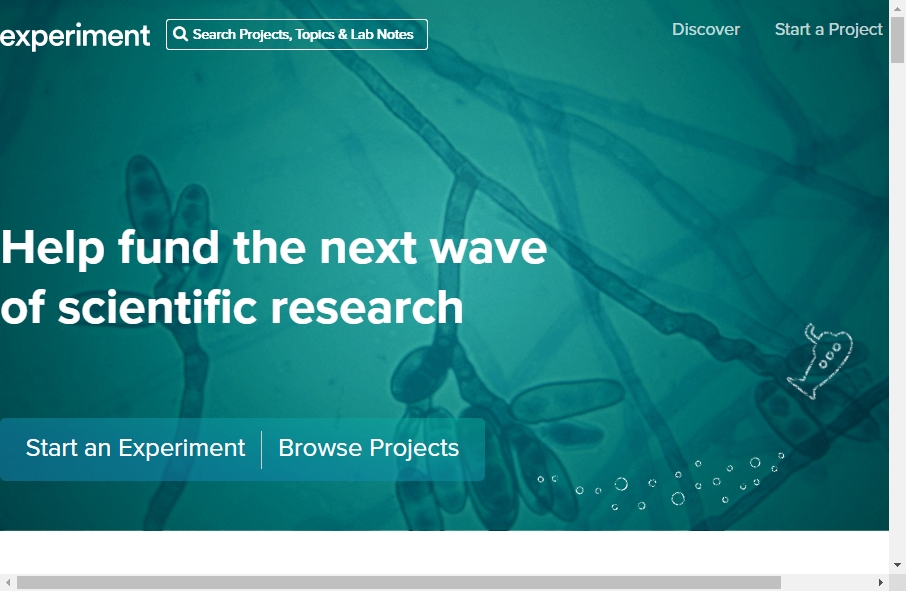
Website: experiment.com
Among other examples of crowdfunding websites, Experiment.com stands out as a platform dedicated to scientific research and innovation, where researchers can seek funding for their projects from a community of backers.
Features:
- A dedicated community of backers interested in scientific research and innovation.
- Resources tailored for researchers to effectively showcase their projects.
- Transparency in project funding and reporting instills trust in backers and project creators.
Pros:
- A unique scientific niche sets Experiment.com apart in the crowdfunding space.
- Attracts backers interested in causes with a positive social impact.
Cons:
- Potential niche limitations may restrict the variety of projects.
-
chuffed.org
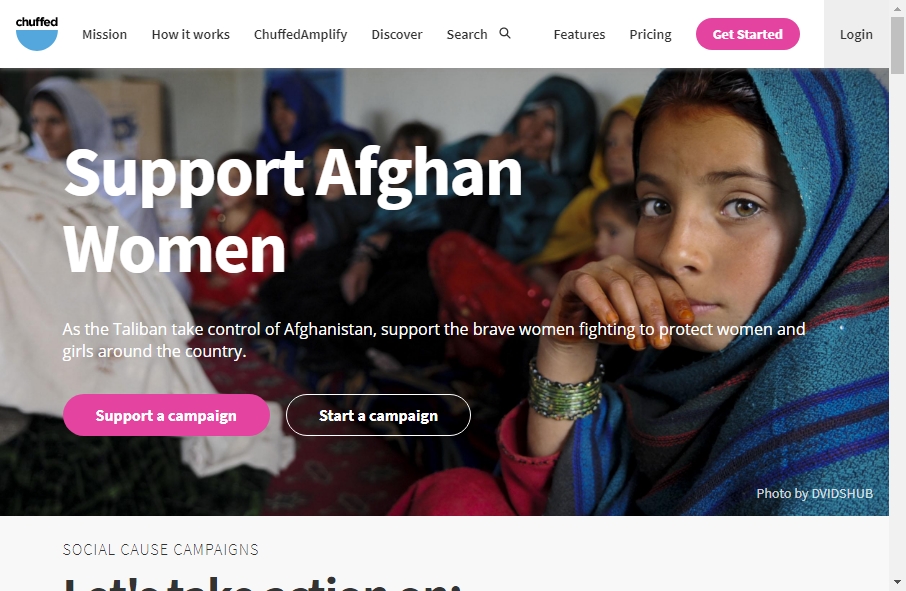
Website: chuffed.org
Chuffed.org managed to create crowdfunding platform specifically for social and nonprofit projects, allowing organizations to raise funds for causes that make a positive impact on society.
Features:
- Focus on crowdfunding for social and nonprofit projects.
- A strong community of passionate backers and organizations.
- Tools and resources that specifically cater to nonprofit organizations and their fundraising needs.
Pros:
- Social and nonprofit causes attract backers interested in making a difference.
- Providing a platform for nonprofit organizations in their fundraising efforts.
Cons:
- Limited diversity of projects on the platform.
-
GoFundMe

Website: gofundme.com
GoFundMe specializes in personal fundraising and charitable causes. It provides a platform for individuals seeking financial support for personal causes, such as medical expenses, education, emergencies, and personal projects.
Features:
- A hub for nonprofit organizations to raise funds for charitable initiatives and community projects.
- Intuitive tools to create campaigns with multimedia uploads and customization.
- Social integration allows easy sharing, allowing users to easily promote their campaigns.
Pros:
- Access to a broad audience.
- Focus on personal and charitable causes covers a spectrum of fundraising needs.
Cons:
- It can be challenging for individual campaigns to stand out in a highly competitive environment.
Thoughts from the crowdfunding platform founders
“Probably one of the most important is you need to learn on your own and not just trust what other people tell you, “This is the way it’s going to be.” Sometimes there is these concepts of reality that are not true, and you just need to test it on your own to find out what is the real feedback.” – Slava Rubin, Co-founder at Indiegogo
“One thing we’ve got a lot better at over the years is coaching; educating the businesses on how to tell their story better, stressing the mission that they’re on, telling that human story behind what they’re doing, making sure that they’re communicating the market opportunity, and showing that they have right team in place to be able to execute their plan.” – Luke Lang, Co-founder at Crowdcube.
How to choose a crowdfunding niche
Selecting the right niche before you dive head-first into your crowdfunding website development is pivotal for its success.
As you are looking at the examples of crowdfunding websites, consider these factors:
Identify your interests and expertise. Choose a niche that you love; it will make the journey more enjoyable and rewarding.
- Make a list of your interests and areas of expertise.
- Highlight the causes that genuinely excite you and align with your knowledge and passion.
- Consider the projects you would enjoy supporting and promoting. Remember, your enthusiasm will resonate with others.
Research market trends. Understand the potential for your chosen niche. Is there demand, and is it growing?
- Use tools like Google Trends, industry reports, and social media listening to identify emerging popularities.
- Explore related communities and forums to gather insights into what’s currently hot in the niche.
Assess competition. What sets you apart? How can you offer something unique?
- Conduct a competitive analysis. Identify existing crowdfunding platforms in your chosen niche.
- Determine what makes them stand out. What unique features or value propositions do they offer?
- Explore gaps in the market. Can you provide something that competitors are missing?
Survey potential users’ needs. Understand the user journey in your niche and decide how you will provide an outstanding experience at critical points.
- Create user surveys or conduct interviews with individuals who are likely to use your platform.
- Identify low points and moments of delight in the customer journey.
- Use the feedback to design your platform to provide ultimate shortcuts and lifehacks in the right places.
Validate your choice. Before finalizing your niche, test your findings with a small group of potential users.
- Create a pilot campaign related to your niche to assess the response.
- Analyze the data and feedback to ensure your chosen niche is viable and resonates with your target audience.
Stay Open to Adaptation. Be flexible and open to adjusting your niche based on market feedback and changing trends.
- Regularly monitor market dynamics and user preferences to refine your niche strategy over time.
Choosing a niche is not a one-time definite decision; it’s an ongoing process that involves continuous monitoring and adaptation.
By following the actionable steps above, you’ll have the potential for long-term success in the crowdfunding space.
How to attract high-quality projects
Once you’ve established your crowdfunding platform, attracting high-quality projects is the key to success.
Here are a few tips to help you along the way.
- Trust building is essential. Make sure you offer exceptional customer service – be there for your users, help them, and address their concerns promptly.
- Success stories are gold! Showcase them on your platform. They’re like testimonials that build trust and confidence in potential project creators.
- Encourage users to leave reviews and ratings. Positive reviews boost your platform’s credibility.
- Seek partners that fit your platform’s niche. If you’re all about tech innovations, partnering with tech-related organizations can be a game-changer.
- Offer incentives. Consider giving high-quality projects a break on platform fees or extra marketing support. It’s a win-win.
- Create community — be the cool host and organize discussions, webinars, or forums related to your niche.
- Make your users feel special by recognizing and rewarding active members.
- Show off your platform’s superpowers. Have a dedicated section and explain how your innovative features can turbocharge projects.
Remember, this is all about creating a comfortable, friendly, and supportive environment for your users.
How long does it take to develop a crowdfunding website?
The timeline for a crowdfunding website development can vary depending on many factors. These factors include the complexity of the projects, the features you want to include, your development team’s expertise, and any potential customization.
Here’s a rough estimate of the time required for different phases of the development process:
| Planning and research | 2-4 weeks | This phase involves defining your platform’s niche, target audience, and unique selling points. You’ll also conduct market research and create a detailed project plan. |
| Design and Prototyping | 4-8 weeks | During this phase, you’ll work on the website’s design, creating wireframes and prototypes to visualize the user interface and user experience. |
| Development | 12-24 weeks | The actual development phase can take several months, depending on the complexity of the website. Key factors include the number of features, the integration of payment gateways, user authentication, and frontend-backend development. |
| Testing and Quality Assurance | 4-8 weeks | Extensive testing is essential to ensure the platform is free from bugs, performs well, and offers a secure environment. This phase can be time-consuming. |
| Content Creation | 4-8 weeks | Creating and populating the website with content, including FAQs, blog posts, and platform policies, can take time. |
| User Testing and Feedback | 2-4 weeks | Inviting a small group of users to test the platform and provide feedback can help identify any remaining issues and improvements. |
| Optimization | 2-4 weeks | Based on user feedback, you’ll need some time to make final adjustments and optimize the platform’s performance and user experience. |
| Launch Preparation | 2-4 weeks | This phase includes preparing for the official launch, such as setting up hosting, domain registration, and final security checks. |
| Soft Launch (optional) | 2-4 weeks | Some platforms opt for a soft launch to test the platform in a live environment with a limited user base before the full-scale launch. |
| Full-Scale Launch | 1 week | The actual launch day is relatively quick, but it involves a lot of coordination to ensure everything goes smoothly. |
Keep in mind that these estimates are general guidelines, and the actual development timeline as well as cost of website development can vary. The entire process can take 8 to 18 months or even longer for more complex projects.
We at Fireart recommend having a clear project plan, experienced developers, and good project management to ensure a successful and timely launch.
Cooperating with Fireart
Do you already have ideas for a new shiny crowdfunding website when looking at these examples?
If you’re looking for a trusted partner in your crowdfunding web design creation, Fireart is here to assist you. We bring years of experience in web design, development, and user experience, and we can make your crowdfunding platform stand out.
See our works to check our past successes, and shoot us a word to claim a website design calculation for free.
With the right features and outstanding design, your crowdfunding website will thrive. Let’s embody your vision and do the world some good!
Check out more examples of industry-focused website designs:





















